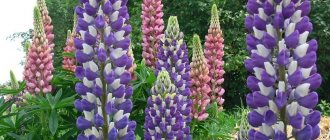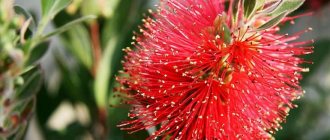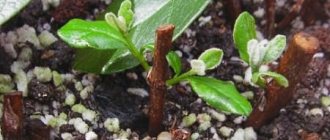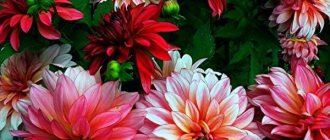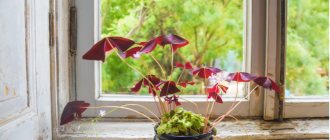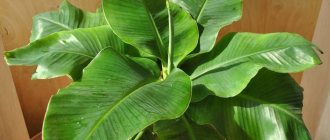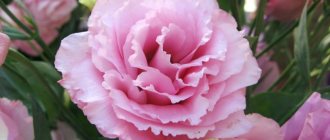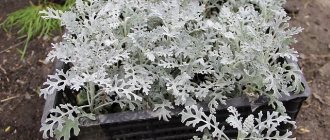Common growing questions
How to achieve year-round flowering?
New Guinea hybrids are capable of blooming all year round, provided that all growing recommendations are strictly followed. How to choose the right soil and pot? The plant is not picky about the choice of soil, so it can use universal soil with the addition of baking powder. The pot for balsam should be a bit cramped, but roots should not be allowed to grow through the drainage holes.
Is balsam pruning and pinching necessary? Mature plants need pinching. This is especially true for highly branching hybrids.
Can the plant grow in open ground? The flower can be planted in garden plots subject to a certain temperature regime. The temperature difference between day and night should not exceed 5°C.
New Guinea hybrids are very popular among gardeners. This excitement is due to the great attractiveness of the plants and their unpretentiousness.
Caring for New Guinea balsam at home
Growing balsam at home will not cause any trouble. Often, difficulties arise with inexperienced flower growers who do not know or neglect the recommendations of specialists.
Is it possible to keep balsam at home?
Several folk signs and superstitions are associated with keeping balsam at home. The most common of them says that Vanka Mokry in the house means that the husband is drunk. Perhaps this sign arose due to the plant’s property of releasing drops of juice on its stems.
Another popular wisdom contradicts the previous statement. According to her, it is possible to keep a flower at home, and growing a flower brings male happiness to the owner of the house. His financial affairs are going well and he is building good relationships with his family.
Another sign identifies balsam as a source of home comfort. A house in which there is a flower will become much cozier and more hospitable. The plant emits positive energy aimed at harmonizing family relationships. If household members begin to quarrel, the balsam will begin to wither. As soon as mutual understanding reigns in the family again, the plant will begin to grow.
Lighting
Impatiens is considered a light-loving plant. It is recommended to place it on windowsills facing western or eastern directions. It is there that the flower receives enough bright diffused light.
A south-facing location may pose problems. When exposed to direct rays of the midday sun, the flower can get burned.
Therefore, if he is destined to live in a southern room, the pot should be shaded at least with a curtain, or better yet, placed in close proximity to the window.
The north side is not suitable for growing balsam. To provide it with the proper amount of light, you will have to direct phytolamps to the flower. Without them, the plant will stretch, losing its decorative effect.
Temperature and humidity
Balsam is quite thermophilic. He is comfortable in the temperature range from 18°C to 24°C. Some gardeners advise taking the pot outside. The plant really benefits from fresh air, but before you take it out into the garden, you should take into account the weather conditions.
Since the flower does not tolerate sudden changes in temperature, it can only be taken out when the difference between day and night temperatures does not exceed 5°C.
For the same reason, it is not recommended to place a flower pot in a place exposed to a draft or under a running air conditioner.
The optimal humidity level for growing balsam is considered to be 40-60%. This is a low level, typical for residential premises. It is necessary to increase humidity only during periods of heat and when heating appliances are operating. In summer, the flower is sprayed with soft water. And in winter it can be placed on a tray with wet pebbles.
Watering and fertilizing
It is recommended to water the flower through a tray. In summer, the soil is moistened daily; in winter, watering is reduced to once a week. Excess water must be drained. Stagnation of moisture in the pan provokes the development of rot.
For irrigation use soft water at room temperature. It is advisable to use rainwater. If this is not possible, household water should be pre-filtered.
Note! During the period of active growth, the flower is fertilized every 2 weeks. Mineral complexes are used as fertilizers for ornamental flowering plants.
The root system of balsam is very susceptible, so experts advise reducing the recommended dosage by half
When choosing a fertilizer, you should pay special attention to the composition. Complexes with a high potassium concentration and low nitrogen content are suitable for the plant.
Sowing balsam for seedlings
Typically, Waller's balsam is grown for summer flowering in the garden, sowing the seeds in March-April. However, if you have lighting and, most importantly, a great desire to decorate your windowsill with a bright flower, without waiting for spring, you can start sowing “light” seeds even in the middle of winter.
Flowering of most modern hybrids begins 3 months (90-100 days) after germination. Thus, if you decide to sow a “light” in December-January, you can get flowering balsam bushes by March 8th. But first, of course, you need to decide on the variety.
Whenever you start growing balsam from seeds - in early winter or traditionally in mid-spring - it is important to consider some of the characteristics of this plant. In particular, if improperly stored, balsam seeds quickly lose their viability
Balsam seedlings appear faster in the light. Nevertheless, it is recommended to place the seeds not superficially, but slightly deepen them, so as not to get seedlings “in caps” (with a seed shell that prevents the cotyledons from opening).
Individual balsam seedlings initially lag significantly behind the main mass, have clumsy cotyledons and small true leaves, so it is better to immediately remove defective specimens, because in the future they will never develop into quality plants.
Impatiens is a tropical flower; its seeds require high temperatures to germinate, so it is better to keep the containers close to the radiator. Subsequently, it is also necessary to provide the seedlings with a temperature of at least 20 degrees (keep in mind that it is usually cooler in the window than in the main room) and protected from drafts.
On average, it takes 7-10 days for Waller's balsam seeds to germinate. After the emergence of seedlings, a phytolamp should be immediately installed over plants sown in winter, which should work for at least 8-10 hours a day.
There is absolutely no need to rush into picking, since even grown seedlings will tolerate replanting well. When 2 to 4 true leaves appear on the plants, the seedlings can be planted in separate containers
At the same time, take into account that “lights” do not bloom well in pots that are too spacious. Therefore, the first container for young balsams should be pots with a volume of 300-500 mm cubic, and 1.5 liter bowls are suitable for adult specimens
Buds on young plants begin to appear when the bushes grow more than five pairs of leaves.
Balsam Accent series. Lyudmila SvetlitskayaHybrid of balsam “Apple blossom” (Athena Appleblossom). Lyudmila Svetlitskaya Balsam “Strawberries with cream”. Lyudmila Svetlitskaya
Caring for New Guinea balsam
Impatiens, including the New Guinea species, are quite unpretentious plants. However, if unfavorable factors arise, they lose their decorative appearance. In this regard, their successful indoor cultivation requires compliance with certain conditions.
Planting and soil
There is a wide variety of varieties of balsam of the New Guinea species, which differ in appearance: shades of leaves and colors of flowers, stem height. Many of the varieties are suitable for indoor growing.
Compact small and medium varieties are intended for growing in pots, while large tall varieties are best grown in flower beds as garden flowers. However, in the summer, smaller varieties of “impatiens” can be planted in open ground or taken outside. This causes a good reaction in the form of luxurious flowering.
New Guinea balsam requires a breathable substrate of loose consistency with a pH level of 5.8-6.2, as well as a drainage layer.
Pot
Be sure to have drainage holes in the pot. For young balsam, dishes with a diameter of 10-12 centimeters are suitable.
Transfer
Due to rapid development, balsam loses its decorative effect after 2 or 3 years. Therefore, adult plants do not need to be transplanted, but renewed by cuttings.
Young flowers need replanting, and it can be done at any time of the year, since balsam does not need a dormant period.
Watering
You should water moderately, but do not forget that the flower readily absorbs moisture.
When watering, you need to avoid getting water on the lower leaves and excess moisture, which can stagnate and lead to rotting of the roots and leaves.
Air humidity
Air humidity in the plant’s habitat should not exceed 60-70% and fall below 40%. In winter, in conditions of increased dry air, it is recommended to spray twice during the day, since a lack of humidity causes the leaves to fall off. You can also use a method such as placing the pot on a tray with moistened expanded clay.
Thermal mode
New Guinea balsams like a moderately warm atmosphere between 17-24 degrees Celsius. Sudden changes in temperature are extremely undesirable, therefore, in the summer, indoor plants are allowed to stay outdoors only under stable warm conditions, when the temperature at night does not fall below the daytime temperature by more than 5 degrees.
Balsam does not tolerate drafts and even short-term hypothermia
Light mode
Impatiens need fairly intense lighting without direct sunlight. Good location - windows facing east and west.
If there is insufficient flowering in the cold months of the year, it is recommended to use additional lighting with special lamps.
Wintering
The plant tolerates the winter season well if suitable conditions are created for it:
- Moderate watering;
- Warm room temperature;
- Spraying when there is a lack of humidity;
- Additional lighting with artificial light.
For connoisseurs of the beauty of balsams, we have prepared materials with descriptions and information on growing varieties such as Garden, Wallera, Camellia and Terry.
Reproduction methods
New Guinea balsam is successfully propagated by cuttings. In order to propagate it, the upper part of the plant with several nodes is used. The cuttings are placed in water or rooted in wet sand. Root growth occurs over 15-20 days. Then the young flower is planted in a pot with a diameter of 10-12 centimeters. The soil used is universal. Drainage is required.
Propagation from seeds seems to be a more difficult method due to the risk of low seedling germination and low survival rate of weak shoots.
Growing Balsam New Guinea from seeds
Before starting cultivation, it is recommended to make sure that the purchased seeds are fresh, since they are good for 6 months and will not sprout if they take longer. Growing stages:
- The seeds are sown in a shallow container filled with a peat-based substrate;
- The substrate is moistened;
- The container with the seeds is placed in a warm, wind-free place and covered with film to create a greenhouse effect;
- Seeds germinate in 5-8 days;
- After the formation of a pair of leaves on the sprouts, a dive is made;
- Young plants are transplanted into pots 4-5 weeks after sowing the seeds.
Trimming
Pruning balsam is an undesirable procedure, as it leads to the formation of keratinized stumps that disrupt the integral decorative appearance. For lush branching, it is recommended to pinch out young shoots.
Bloom
Touch-me-not has no clearly defined periods of flowering and dormancy.
Everything depends on the state of the environment. It is capable of blooming all year round under appropriate decent conditions. Summer time is characterized by abundant flowering , and when in an open garden, New Guinea balsam simply “drowns” in beautiful flowers.
New Guinea hybrids and the simple reason for their growing popularity
Among all the varieties, groups of varieties and even types of balsams (Impatiens), the so-called hybrid varieties of the Nuova Guinea group or New Guinea hybrids (often labeled as New Guinea Impatiens) are today considered the best, although some time ago these plants were considered one of the most capricious and exclusively "Western".
The change in status and growing popularity of New Guinea impatiens has a simple explanation: these plants boast a unique ability to bloom all year round. And although in regions with harsh winters they are grown only as seasonal plants in the garden, they have no equal in indoor culture. The unique duration of flowering can be appreciated even in the middle zone.
The two main features of New Guinea hybrids are meatiness and power. They have strong shoots, very densely spaced bright dark green leaves and pretty bright asymmetrical flowers, as if evenly scattered throughout the bush. The beauty of both greenery and flowering sets them apart from more than half a thousand species and many thousands of varieties of balsams. And it seems inappropriate to assign popular nicknames to this plant - light, Vanka wet, touchy. Although the main feature of balsams - scattering of seeds, cracking of the capsule at the slightest touch - is also preserved by the New Guineans.
New Guinea hybrids first appeared on the flower market in 1972, and the group of these hybrids can be called relatively young. It is believed that they were bred by crossing the Indonesian Impatiens Hawker with other species. These plants, up to 20-30 cm high, can be considered both indoor and garden varieties, but they fully display their talents indoors. In fact, these are universal varieties that can be used at your discretion. They have very compact, dense bushes and much stronger shoots that are more resistant to injury than ordinary impatiens.
The leaves are dense, broadly lanceolate, sit on short petioles in whorls, decorated with a finely serrated edge; in some varieties they can reach 10 cm in length. “Recessed” veins are clearly visible on the leaf blades. And the flowers are much fleshier, larger, up to 5-8 cm in diameter, with graceful petals and a small colored eye. Flowers bloom in axillary “bundles” or one at a time. In garden culture, New Guinea balsams bloom only in the spring, but when grown indoors, they bloom all year round.
New Guinea hybrids also appreciate the color range - pure pastel or watercolor shades and rare variations of pink shades, fuchsia, candy, salmon, peach, apricot tones. The color of the leaves is also very variable: in addition to intense dark green, different varieties also have brighter variations and original shades - bronze or with a yellowish highlight in the center of the leaf blades.
The variety of New Guinea hybrids allows you to choose both more compact and larger plants, very different from the more familiar Waller's balsam. Actually, according to size, they are divided into three groups - compact (up to 20 cm), spreading and tall (up to 60-90 cm) varieties.
In New Guinea hybrids, it is most often not individual varieties that are distinguished, but entire series of varieties. The best of them include:
- "Macarena" with bronze leaves and orange flowers;
- 'Jangle Rain' - impatiens with pastel, soft colors and glossy dark leaves;
- 'Harmony' is a variety series with densely branching compact bushes, bright red, bronze or green foliage and almost round, dense flowers;
- 'Rainforest Exotic' - balsams, whose bright “tropical” colors in single and two-color variations go well with dark leaves;
- "Java" is a series of plants with bright orange-pink-red "acrylic" tones and green or bronze leaves;
- “Mini Gini” is a small-flowered series, the plants of which have dark bushes strewn with hundreds of small flowers;
- “Divaro” is a series of compact, densely branched balsams with bright green leaves and medium-sized, neat flowers;
- 'Spreading White' is a variegated New Guinea with snow-white flowers.
In growing New Guinea balsam hybrids, the most important thing is to choose the right conditions and choose the plant itself with all the attention to the “details”. New Guineans can be found on sale mainly in the spring
But many flower balsams are delivered by autumn. When purchasing bushes, you should carefully inspect them, noting the slightest signs of disease or pest damage: if you miss even a speck, the plant will not be cured and you will most likely just have to throw it away.
A little about this amazing plant
The herbaceous plant that we want to tell you about belongs to the genus Impatiens, which was not named so by chance. All its representatives have one unique feature - at the slightest touch to their seed pod, it bursts with a bang, and the seeds scatter within a radius of 2 meters.
The genus of balsams is numerous, it includes about 500 species of plants, including New Guinea balsam. Today we will talk about it in more detail.
New Guinea balsam.
This plant is a real miracle, because if you provide it with good care, it will delight you with its flowering for six or even eight months a year. New Guinea balsam differs from other balsams in its thick stem, more powerful leaves and flowers. It has a more compact size, which allows it to be grown in small rooms.
Guinea balsam is more resistant to pathogens and parasites, and is more hardy. As a result of the painstaking work of breeders, flower growers are presented with different species that differ in the color of leaves and flowers, as well as the duration of their flowering. Caring for them is the same as for most balsams.
Disembarkation rules
Since we are talking specifically about the garden variety of balsam, we will focus on how to plant it in open ground. The whole growing procedure is quite simple, you just need to delve once into the requirements put forward by this plant for normal growth, and try not to violate them.
First of all, you need to choose the right site. The bush loves bright, but at the same time diffused light, so when choosing a place for it you need to focus on the western or eastern corner of the site. If you choose the right place, there will be no problems with flowering. For comparison: in a heavily shaded place, the balsam will suddenly stretch upward, but there will be less energy left for flowering, so the number of flowers will be halved. It is also better not to plant the plant in open sun. If there is no choice, find a way to shade the bush in the middle of the day.
As a rule, it is customary to plant slightly grown seedlings in open ground, which are planted in advance, because moving outside can be done almost immediately after the last frost. At the same time, a sharp change in conditions from indoors to outdoors is not suitable for the seedlings, so they are accustomed to the new conditions gradually, exposing the pots to the open air for several hours a day before planting.
Impatiens are not planted individually, but they should not grow very densely either. If the distance between the holes is less than 30 cm, individual bushes will interfere with each other. In general, average garden soil is quite suitable for growing such a plant, but if you doubt its nutritional value, then it is better to immediately add a little humus, peat and sand to the hole.
Transplantation looks very simple: you need to remove the seedlings from the container and place them in a hole, then cover them with garden soil or the mixture described above. In order for the bush to take root normally, it is watered immediately and the soil around the stem is immediately covered with mulch for insulation. If you suspect that the bush will stretch upward and lose all its strength, leaving nothing for flowering, you can pinch the top right away.
Popular varieties
There are many varieties of New Guinea balsam, but some are particularly decorative. Since the selection work is very active, not even specific varieties are identified, but varietal groups. They have common features, but may differ in flower color.
Divaro
Representatives of the variety are distinguished by their compact bush, rich green leaf color and small flower size.
Macarena
Macarena
A distinctive feature of the variety is the orange or salmon hue of the flowers. They look especially decorative against the background of green foliage with a hint of bronze.
Rainforest Exotic
Rainforest Exotic
The color of the flowers is always bright shades, the foliage is dark green. There are specimens with two-color petals.
Divine mix
Divine mix
All representatives of the varietal group are distinguished by their compact bush shape. Belongs to the large-flowered varieties. Petals can have different colors.
Jangle Rain
Jangle Rain
The color of the flowers contains only delicate pastel tones. The leaf blade is glossy, dark green.
Harmony
Harmony
The main feature is the reddish tint of the leaf blade in some varieties. The flowers are round in shape and small in size.
Mini Genie
Mini Genie
The small size of the variety's flowers fully compensates for their number. During flowering, the compact bush is almost completely covered with them.
Spreading White
Spreading White
The original variegated variety. The flowers are snow-white in color and have medium-sized petals.
general characteristics
Among the people, balsam has several nicknames: impatiens - because the seed pods burst at the slightest touch. Or Vanka is wet - because after watering, droplets of water remain at the ends of the leaves, which then seem to be candied. The flower was nicknamed Fire for its bright scarlet, red and pink flowers, which are found in most varieties.
The flower grows from small graceful bushes up to 50 cm, depending on the variety. It has a fleshy, strong stem and the same leaves with wavy edges and a bronze or reddish tint.
Flowers are hidden in the axils between the leaves and delight with a variety of color spectrum - especially modern hybrid species. They are orange, white, purple, spotted or striped. The bright color stands out against the background of rich dark leaves, and balsam can bloom all year round - it’s not for nothing that it is called the evergreen.
Photo: dizainexpert.ru
Features of flowering
Like many other flowering houseplants, Waller's Impatiens has periods of activity and dormancy. Care differs at different times.
| Activity period | Impatiens have a fairly long period of activity - from March to December. At this time, the flower develops well and blooms profusely. It is at this time that you need to pay maximum attention to the plant. |
| Rest period | From December to February is a period of rest. At this time, it is necessary to create all the necessary conditions so that the plant enters this state gradually. Only in this case will it bloom next year. |
For your information! Balsam is inimitable during the flowering period. Depending on the variety, flowers can be orange, pink, light pink, coral and many other shades. Particularly beautiful are varieties with double flowers that resemble miniature roses. There are also species that look like an ampelous flower.
Photo
Next in the photo you can look at the plant and admire the beauty of its flowering.
There are more than 400 types of balsam in nature, but in the Northern Hemisphere the following varieties are common: Garden, Wild, Zheleznokosny or Zhelezisty, Tom Samb, as well as Waller's balsam. Flower growers love to grow double and hanging plant species - they will decorate any area or apartment.
Growing seedlings
For seedlings it is better to use:
- biocontainers (pressed vermicompost in granules);
- peat pots or tablets;
- cups with a removable bottom (diameter 10 cm).
When growing seedlings in peat tablets, they are transplanted into a pot when 2 main leaves appear. The tablets will dissolve in the soil and further fertilize the soil.
Grown seedlings are transplanted together with a ball of earth, peat pots or biocontainers. Before this, the plants are hardened off - taken outside for 2-4 hours a day in warm weather. Nasturtium will bloom in 30-45 days.
Preparing seeds and soil
Seeds are prepared before sowing:
- Sorted, removing underdeveloped, small and damaged ones.
- Then they are disinfected by placing them in a solution of potassium permanganate for 15 minutes, heated to 60 degrees.
- Next, the seeds are wrapped in gauze and kept in cool water for 24 hours.
- They can also be germinated a little and then planted in pots.
You can buy soil at a garden store or make it yourself by combining in equal proportions:
- turf land;
- sand;
- peat.
All components are mixed well and sifted. Next, the soil is watered with a hot solution of potassium permanganate for disinfection and left at room temperature for 1-2 days.
The soil is poured into prepared containers and the seeds are sown.
Sowing
- Make a 2 cm depression in the soil and place 2-3 seeds in each container.
- The soil is lightly compacted and watered with warm water from a spray bottle so as not to wash out the seeds.
- Peat tablets are placed in a container and watered. 1-2 seeds are placed in each tablet.
- The containers are left on a bright and warm windowsill.
Seedling care
The room where the seedlings are located should be 20-22 degrees. Then the sprouts will appear in 13-15 days. After 2 weeks of cultivation, the temperature is lowered by 2 degrees.
In poor lighting, the seedlings will begin to stretch, so in the future they will be weak. It is necessary to additionally illuminate the plants with phytolamps so that the seedlings receive daylight for 15 hours.
Watering is carried out as the soil dries. Nasturtium loves dry air, so it does not need to be sprayed.
The strongest plants are left in the container with seedlings, and the rest are removed.
Planting in open ground
The place for nasturtium is chosen to be protected from drafts and well lit. The soil must be fertile, water- and breathable with weak acidity. If the soil is not nutritious, the flowering will be weak and not lush.
Depending on the climate, transplantation into open ground is carried out from early May to early June on a sunny and warm day. By this time, the seedlings should already have grown to 7 cm.
A minimum of 20 cm is left between plants, and for tall and bushy varieties - 40 cm. The holes are dug slightly larger than the volume of the cups with seedlings.
The plant is transferred into holes with a lump of earth, soil is added and watered at the root. Plantings are mulched with peat and compost.
Watch the video! Nasturtium: cultivation and care
When to plant
In order to get beautiful flowering plants, you need to choose the planting date wisely.
General planting times
In the Moscow region and other parts of the European territory of Russia, planting seeds is allowed from the first ten days of March. In the southern regions, you can move this date to February. In the rest of the country, this is not recommended, since the growing season of the crop does not last too long.
Lucky dates according to the lunar calendar
In order to successfully sow balsam seeds, they also resort to the help of the lunar calendar. In accordance with it, in 2022, favorable days for the procedure are:
- February 21-25;
- March 12-17, 19-20;
- April 6-8, 11-13, 15-17, 29-30;
- May 8-17, 21-23, 26-28;
- June 1-2, 5-6, 9-13, 16-20.
It is not recommended to plant seeds on the following dates:
- March 6, 7, 21;
- April 5, 19;
- May 5, 19;
- June 3, 4, 17.
Description of appearance and features
At home, New Guinea balsam can bloom for 10 months. Among gardeners, this property makes the plant very popular.
New Guinea hybrids are distinguished by their power and meatiness. They have strong shoots, bright asymmetrical flowers and very densely spaced leaves. Of the numerous varieties of balsams, these stand out for the beauty of their blooms and the richness of their greenery.
The peculiarities of varietal New Guinea balsam include the fact that the plant sheds its leaves due to:
- hypothermia;
- lack of lighting;
- drying out of the soil.
How the flower will bloom is influenced by the choice of pot, as well as the systematic introduction and composition of fertilizers.
New Guinea hybrids are valued for their colors. Flowers come in different shades:
- pink;
- apricot;
- peach;
- pastel;
- fuchsia, etc.
In addition to the bright dark green color, the leaves are bronze or have a yellowish discoloration in the middle.
Planting balsam by cuttings
For planting and cultivating balsam in open ground and indoor conditions, seedlings are mainly purchased. Growing from seeds is a troublesome and time-consuming task, and for some varieties it is difficult to preserve species characteristics. When choosing balsam in the store, you can buy one that is already blooming in order to determine the shade of the buds.
Flower transplantation must be regular, due to the intensity of growth. One common reason is a cramped pot in which leaves begin to fall. In a pot that is too large, the roots develop well, while the upper part slows down in growth and stops blooming.
To propagate Vanka wet, cuttings are used. To do this, healthy shoots are cut off in the fall and immersed in water or a moist substrate and kept until they take root. Then they make a pick. In winter they are kept warm and planted in a permanent place in the spring.
Pests
Often, pests appear only when the plant’s maintenance conditions are not met. If the air in the room is dry, then there is a high probability of spider mite infestation. It entangles the “impatiens” with a web and sucks the juice from the plant. Thrips often appear. In case of mild damage, balsam is sprayed with alcohol or soap solution. If there are a lot of pests, then a ready-made insecticidal composition will help.
You can observe how small white flies – whiteflies – appear on the “touch-me-not”. Folk remedies will not help here. Treatment is best done with medications. Sticky insect repellent tape that hangs near the flower helps.
Varieties that have light-colored flowers are less resistant to disease than other types.
While admiring your New Guinea green friend, do not forget to periodically inspect the leaves for insects
Pay attention to the soil and make sure there is no green moss. How to care for New Guinea balsam so that it “thanks you” with lush and long flowering? It is enough to pay attention to him
And then in room conditions he can live up to five years.
How to care at home?
In this article we will take a detailed look at caring for New Guinea balsam at home. Rest assured, it does not require any special skills.
Temperature
New Guinea balsam loves warmth and can easily tolerate heat. The ideal mode is a constant temperature within 22-26° without sudden changes and drafts. At temperatures below 12° the balsam will die.
Almost the same temperature regime must be maintained for Clerodendrum - 20-25° in summer, approximately 15° in winter.
Even short-term exposure to cold leads to freezing of the leaves.
Lighting
The New Guinea hybrid loves light no less than heat.
That does not prevent him from suffering from direct exposure to the sun. In order not to harm the plant, it is placed on the windowsill of a western or eastern window.
In winter, additional lighting is provided so that the balsam receives a 14-15 hour light period.
A lack of light will lead to loosening of the bush, loss of its compact shape, the shoots will begin to turn pale and unattractively stretch towards the light source.
Watering
New Guinea balsam needs a lot of moisture; the principle “It is better to over-water than under-water” applies to it. Even short-term dryness causes disastrous consequences and stress in the plant, to which it reacts by wilting of leaves and a decrease in overall turgor. Recovery is going very slowly.
Therefore, it is recommended to moisten the soil in the pot often, but in small portions, to avoid stagnation of water in the pan.
Otherwise, the roots and fleshy stems will begin to rot.
In winter, watering continues in full, without changing the regime and frequency, because New Guinea balsam does not go to rest, continuing to actively develop and bloom.
For watering and spraying, do not use hard water directly from the water supply. The lime contained in it weakens the plant and alkalizes the soil, while balsam prefers a slightly acidic reaction.
Humidity
The optimal figure is 45-55%.
The decline leads to drying and falling of leaf blades and inflorescences, and the cessation of flowering. To avoid this, balsam is sprayed from a spray bottle.
In hot, dry summer weather and the winter heating season, you can place an open container filled with water next to the flower.
Or place the pot on a tray with wet stones. These measures will protect the delicate plant from drying out.
Fertilizer
While flowering continues, the plant is fed with mineral complexes every 2-2.5 weeks. The easiest way is to use a liquid form, which is diluted in water for irrigation.
Nitrogen compounds contribute to fattening of balsam. Instead of active flowering, you can get a lush development of green mass against the background of a meager formation of inflorescences.
How to trim
Only young tops can be pinched.
If you cut off adult shoots, thick “stumps” will remain, which sharply reduce the decorative value of the balsam.
In general, pruning is required very rarely, since the hybrid itself perfectly forms a beautiful bush shape and branches.
The exception is the Harmony series; it is pinched to obtain a beautiful semicircular bush.

